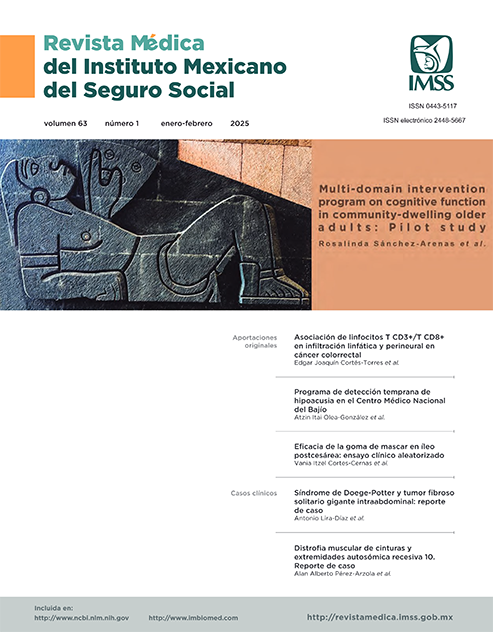Autosomal recessive limb-girdle muscular dystrophy-10. Case report
Main Article Content
Keywords
Connectin, Muscular Dystrophies, Limb-Girdle, Muscle Weakness, Muscular Diseases
Abstract
Background: The autosomal recessive limb-girdle muscular dystrophy-10 (LGMDR10) is a muscular dystrophy caused by pathogenetic variants in the TTN gene encoding the titin protein, which is responsible for muscle flexibility and tension. Its prevalence is unknown. The main clinical manifestations are proximal muscle weakness predominantly in the shoulder girdle and pelvic girdle, mild weakness of distal muscles and muscle atrophy. The objective is to present a case report of autosomal recessive limb-girdle muscular dystrophy-10 in a Mexican patient.
Clinical case: 39-year-old male with hypotrophy of the left leg, muscle weakness of the 4 limbs predominantly proximal and asymmetrical, myalgia and nocturnal cramps. Total creatine phosphokinase level was of 819.7 IU/L, nerve conduction velocity and electromyography with left femoral neuropathy of the axonotmesis type and mixed axonal neuropathy with myopathic pattern of upper limbs. The molecular study for muscular dystrophies reported 2 pathogenic variants in compound heterozygous state in the TTN gene: c.107578C>T (p. Gln37860*) and c.104269C>T (p. Gln34767*), respectively.
Conclusions: In line with the information available, there are no reported cases of LGMDR10 in Mexico. This is a progressive disease with total loss of ambulation between the fourth and the sixth decade of life, which is why its clinical suspicion is important for a timely diagnosis, an adequate counseling, and preventive measures of complications for a better quality of life.
References
Udd B, Vihola A, Sarparanta J, et al. Titinopathies and extension of the M-line mutation phenotype beyond distal myopathy and LGMD2J. Neurology. 2005;64(4):636-42. doi: 10.1212/01.WNL.0000151853.50144.82
Rich KA, Moscarello T, Siskind C, et al. Novel heterozygous truncating titin variants affecting the A-band are associated with cardiomyopathy and myopathy/muscular dystrophy. Mol Genet Genomic Med. 2020;8(10):e1460. doi: 10.1002/mgg3.1460
Bouchard C, Tremblay JP. Limb-Girdle Muscular Dystrophies Classification and Therapies. J Clin Med. 2023;12(14):1-15. doi: 10.3390/jcm12144769
Chen Q, Zheng W, Xu H, et al. Digenic Variants in the(espacio)TTN(espacio)and(espacio)TRAPPC11(espacio)Genes Co-segregating With a Limb-Girdle Muscular Dystrophy in a Han Chinese Family. Front Neurosci. 2021;15:601757. doi: 10.3389/fnins.2021.601757
Reyes L, Villamar P, Espinosa N. Distrofia muscular de cinturas 2J, revisión bibliográfica y reporte de un caso pediátrico en Ecuador.(espacio)Metro Ciencia. 2020;(espacio)28(3):8-13. doi: 10.47464/MetroCiencia/vol28/3/2020/8-13
Georganopoulou DG, Moisiadis VG, Malik FA, et al. A Journey with LGMD: From Protein Abnormalities to Patient Impact. Protein J. 2021;40(4):466-88. doi: 10.1007/s10930-021-10006-9
Lombardo ME, Carraro E, Sancricca C, et al. UILDM (Italian Muscular Dystrophy Association) and Italian Consensus Conference Group on motor rehabilitation in muscular dystrophy. Management of motor rehabilitation in individuals with muscular dystrophies. 1st(espacio)Consensus Conference report from UILDM - Italian Muscular Dystrophy Association (Rome, January 25-26, 2019). Acta Myol. 2021;40(2):72-87. doi: 10.36185/2532-1900-046
Morishima R, Schoser B. A Straightforward Approach to Analyze Skeletal Muscle MRI in Limb-Girdle Muscular Dystrophy for Differential Diagnosis: A Systematic Review.(espacio)Muscles.(espacio)2023;2:374-388. doi: 10.3390/muscles2040029 (espacio)
De Paepe B, Velghe E, Salminen L, et al. Diagnostic muscle biopsies in the era of genetics: the added value of myopathology in a selection of limb-girdle muscular dystrophy patients. Acta Neurol Belg. 2021;121(4):1019-33. doi: 10.1007/s13760-020-01559-0
Li C, Haller G, Weihl CC. Current and Future Approaches to Classify VUSs in LGMD-Related Genes. Genes (Basel). 2022;13(2):382. doi: 10.3390/genes13020382
Straub V, Murphy A, Udd B. 229th ENMC international workshop: Limb girdle muscular dystrophies - Nomenclature and reformed classification Naarden, the Netherlands, 2018;28(8):702-10. doi: 10.1016/j.nmd.2018.05.007
Savarese M, Vihola A, Oates EC, et al. Udd B. Genotype-phenotype correlations in recessive titinopathies. Genet Med. 2020;22(12):2029-40. doi: 10.1038/s41436-020-0914-2
Savarese M, Sarparanta J, Vihola A, et al. Increasing Role of Titin Mutations in Neuromuscular Disorders. J Neuromuscul Dis. 2016;3(3):293-308. doi: 10.3233/JND-160158
Misaka T, Yoshihisa A, Takeishi Y. Titin in muscular dystrophy and cardiomyopathy: Urinary titin as a novel marker. Clin Chim Acta. 2019;495:123-8. doi: 10.1016/j.cca.2019.04.005
Nigro V, Savarese M. Genetic basis of limb-girdle muscular dystrophies: The 2014 update. Acta Myol. 2014;33(1):1-12.
Leońska-Duniec A, Borczyk M, Piechota M, et al. TTN(espacio)Variants Are Associated with Physical Performance and Provide Potential Markers for Sport-Related Phenotypes. Int J Environ Res Public Health. 2022;19(16):10173. doi: 10.3390/ijerph191610173
Chen Q, Zheng W, Xu H, et al. Digenic Variants in the TTN and TRAPPC11 Genes Co-segregating With a Limb-Girdle Muscular Dystrophy in a Han Chinese Family. Front Neurosci. 2021;15:601757. doi: 10.3389/fnins.2021.601757
Loescher CM, Hobbach AJ, Linke WA. Titin (TTN): from molecule to modifications, mechanics, and medical significance. Cardiovasc Res. 2022;118(14):2903-18. doi: 10.1093/cvr/cvab328
Jolfayi AG, Kohansal E, Ghasemi S, et al. Exploring TTN variants as genetic insights into cardiomyopathy pathogenesis and potential emerging clues to molecular mechanisms in cardiomyopathies. Sci Rep. 2024;14(1):5313. doi: 10.1038/s41598-024-56154-7
Wang G, Lv X, Xu L, et al. Novel compound heterozygous mutations in the TTN gene: elongation and truncation variants causing limb-girdle muscular dystrophy type 2J in a Han Chinese family. Neurol Sci. 2022;43(5):3427-33. doi: 10.1007/s10072-022-05979-z
Rees M, Nikoopour R, Fukuzawa A, et al. Making sense of missense variants in TTN-related congenital myopathies. Acta Neuropathol. 2021;141(3):431-53. doi: 10.1007/s00401-020-02257-0
Pénisson-Besnier I, Hackman P, Suominen T, et al. Myopathies caused by homozygous titin mutations: Limb-girdle muscular dystrophy 2J and variations of phenotype. J Neurol Neurosurg Psychiatry. 2010;81(11):1200-2.
Khan A, Wang R, Han S, et al. Homozygous missense variant in the TTN gene causing autosomal recessive limb-girdle muscular dystrophy type 10. BMC Med Genet. 2019;20(1):166. doi: 10.1186/s12881-019-0895-7
Pozsgai E, Griffin D, Potter R, (espacio)et al. Unmet needs and evolving treatment for limb girdle muscular dystrophies. Neurodegener Dis Manag. 2021;11(5):411-29. doi: 10.2217/nmt-2020-0066


